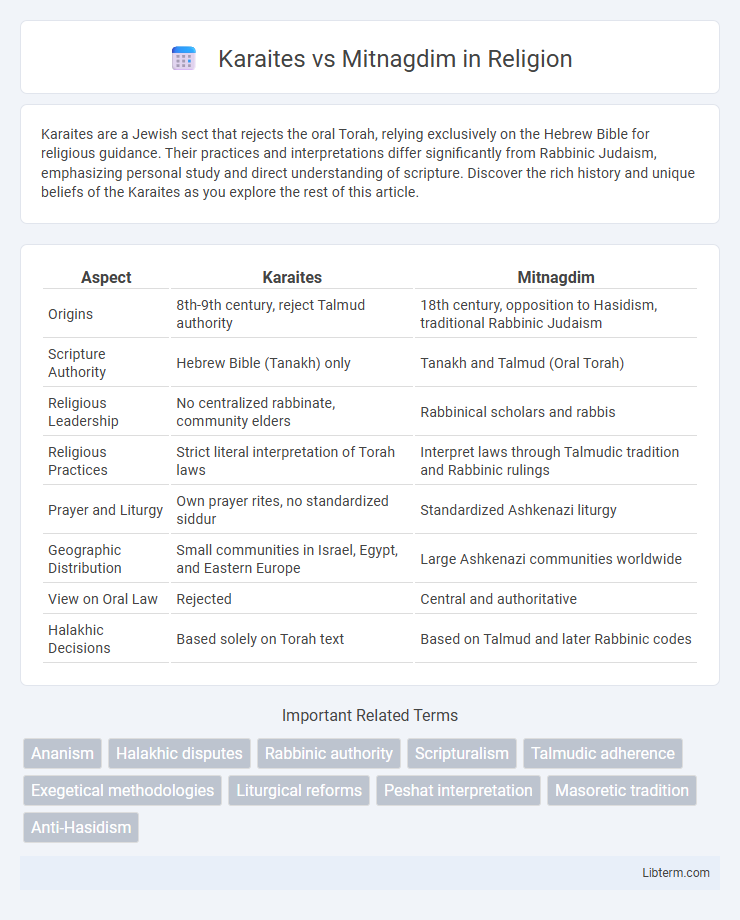Karaites are a Jewish sect that rejects the oral Torah, relying exclusively on the Hebrew Bible for religious guidance. Their practices and interpretations differ significantly from Rabbinic Judaism, emphasizing personal study and direct understanding of scripture. Discover the rich history and unique beliefs of the Karaites as you explore the rest of this article.
Table of Comparison
| Aspect | Karaites | Mitnagdim |
|---|---|---|
| Origins | 8th-9th century, reject Talmud authority | 18th century, opposition to Hasidism, traditional Rabbinic Judaism |
| Scripture Authority | Hebrew Bible (Tanakh) only | Tanakh and Talmud (Oral Torah) |
| Religious Leadership | No centralized rabbinate, community elders | Rabbinical scholars and rabbis |
| Religious Practices | Strict literal interpretation of Torah laws | Interpret laws through Talmudic tradition and Rabbinic rulings |
| Prayer and Liturgy | Own prayer rites, no standardized siddur | Standardized Ashkenazi liturgy |
| Geographic Distribution | Small communities in Israel, Egypt, and Eastern Europe | Large Ashkenazi communities worldwide |
| View on Oral Law | Rejected | Central and authoritative |
| Halakhic Decisions | Based solely on Torah text | Based on Talmud and later Rabbinic codes |
Historical Origins of Karaites and Mitnagdim
Karaites originated in the 8th-9th centuries as a Jewish sect rejecting the Talmudic Oral Law, emphasizing strict adherence to the Hebrew Bible alone. Mitnagdim emerged in the 18th century as opponents of the Hasidic movement, prioritizing traditional Rabbinic Judaism and Talmud study. The Karaites' historical roots trace back to Anan ben David, while Mitnagdim were led by figures like the Vilna Gaon, solidifying their ideological distinctions within Jewish history.
Key Theological Differences
Karaites reject the Oral Torah and rely solely on the Hebrew Bible (Tanakh) for religious law, while Mitnagdim uphold the authority of the Talmud and rabbinic interpretations. Karaites emphasize personal interpretation of scripture without rabbinic mediation, contrasting with the Mitnagdim's adherence to established halachic traditions. The rejection of rabbinic law by Karaites fundamentally distinguishes their theological framework from the Mitnagdim's commitment to normative Judaism and the Oral Law.
Scriptural Interpretations: Torah vs Talmud
Karaites strictly adhere to the Hebrew Bible (Torah) as the sole authoritative scripture, rejecting the Oral Torah and Talmudic interpretations upheld by the Mitnagdim. Mitnagdim emphasize the Talmud's role in elucidating and applying the Torah's laws, viewing the Oral Torah as essential for understanding scriptural commandments. This fundamental divergence shapes their distinct religious practices, with Karaites relying on direct biblical text and Mitnagdim following rabbinic traditions codified in the Talmud.
Prayer Practices and Religious Observance
Karaites strictly adhere to the Hebrew Bible, rejecting the Oral Torah, which leads to unique prayer practices emphasizing direct scriptural wording without Rabbinic additions found in Mitnagdim liturgy. Mitnagdim follow the Ashkenazi tradition that incorporates the Talmud and other Rabbinic texts, shaping their communal prayers and observances with established liturgical structures and fixed prayer times. These divergent foundations result in Karaites often praying individually or in small groups, focusing on literal biblical injunctions, while Mitnagdim engage in formal synagogue services with standardized melodies and rituals passed down through Rabbinic authority.
Responses to Rabbinic Authority
Karaites reject rabbinic authority, relying solely on the Hebrew Bible (Tanakh) for religious law, leading them to interpret texts independently without the Talmud's guidance. Mitnagdim uphold strict adherence to rabbinic authority, emphasizing the central role of the Talmud and the interpretations of leading rabbis in shaping Jewish law and practice. This fundamental disagreement over the legitimacy of rabbinic texts underpins their divergent religious philosophies and communal identities.
Influence on Jewish Communities
Karaites, rejecting Rabbinic oral law, influenced Jewish communities by emphasizing strict adherence to the Hebrew Bible, prompting debates on scriptural interpretation and halachic authority. Mitnagdim, opposing Hasidic innovations, reinforced traditional Talmudic study and centralized Rabbinic authority, shaping Lithuanian and Eastern European Jewish educational systems. The ideological clash between Karaites and Mitnagdim impacted communal cohesion, legal practices, and the development of diverse Jewish religious identities.
Social and Cultural Distinctions
Karaites reject the Talmud and Rabbinic traditions, emphasizing direct interpretation of the Hebrew Bible, which results in unique religious practices and observances distinct from Mitnagdim. Mitnagdim, followers of Rabbinic Judaism, uphold Talmudic scholarship and traditional yeshiva study, fostering a communal culture centered on rabbinic authority and halakhic development. Socially, Karaites often maintain insular communities to preserve their distinct identity, while Mitnagdim actively engage in broader Jewish communal life and intellectual discourse.
Major Historical Conflicts and Interactions
The Karaites and Mitnagdim historically clashed over religious authority and interpretation of Jewish law, with Karaites rejecting the Oral Torah upheld by the Mitnagdim. Major conflicts occurred throughout the medieval period, notably in Eastern Europe, where Mitnagdim opposed Karaite communities' divergent scriptural readings and practices. These tensions led to social exclusion and legal disputes, shaping distinct communal boundaries that persisted into modern times.
Legacy and Modern-day Presence
The Karaites maintain a distinct legacy as a Jewish sect rejecting Rabbinic oral law, preserving their own scriptural interpretations since the 8th century. The Mitnagdim, opponents of Hasidism, emphasize rigorous Talmudic study and remain influential in Orthodox Judaism's leadership and yeshiva networks. In modern-day communities, Karaites are primarily concentrated in Israel and parts of the United States, while Mitnagdim continue to wield significant religious authority across global Orthodox Jewish populations.
Continuing Impact on Jewish Identity
Karaites, who reject the Talmud and rely solely on the Hebrew Bible, maintain a distinct religious identity that challenges traditional Rabbinic norms upheld by the Mitnagdim, followers of the Vilna Gaon who emphasize rigorous Talmudic study. This ongoing divergence influences Jewish identity by highlighting the spectrum of scriptural interpretation and legal authority within Judaism. The tension between Karaites and Mitnagdim underscores broader debates on religious authority, community boundaries, and the preservation of diverse Jewish traditions.
Karaites Infographic

 libterm.com
libterm.com